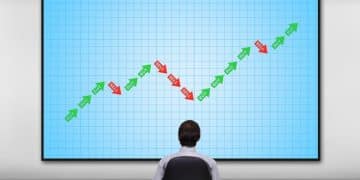Maximizing Your 401(k) in 2025: Strategies for a $500,000 Retirement Fund

Maximizing Your 401(k) in 2025 involves strategic planning, consistent contributions, and smart investment choices; this guide details expert strategies to help you reach a $500,000 balance by retirement, focusing on leveraging employer matches and optimizing asset allocation.
Ready to supercharge your retirement savings? Discover expert strategies for maximizing your 401(k) in 2025 and building a substantial nest egg of $500,000 by the time you retire.
Understanding the 2025 401(k) Landscape
The 401(k) landscape is constantly evolving. Understanding the current rules, contribution limits, and potential changes is crucial for effective retirement planning.
Staying informed allows you to make the most of your retirement savings opportunities. Let’s delve into what you need to know about the 2025 401(k) environment.
Contribution Limits for 2025
One of the first things to understand is the contribution limits. These limits dictate how much you can contribute each year to your 401(k) account.
Catch-Up Contributions
For those nearing retirement age, catch-up contributions are a valuable tool. These contributions allow individuals aged 50 and older to contribute more than the standard limit.
- Regular Contribution Limit: Understanding the base amount you can contribute annually.
- Catch-Up Contribution Limit (Age 50+): The additional amount those 50 and older can contribute.
- Tax Advantages: The benefits of contributing pre-tax versus Roth options.

Staying informed about contribution limits and catch-up options is a cornerstone of effective 401(k) planning. Make sure to adjust your contributions accordingly to take full advantage of these limits.
Setting a $500,000 Goal: Is It Realistic?
Setting a $500,000 goal for your 401(k) requires careful consideration. Evaluating its feasibility based on your age, income, and current savings is essential.
This goal may seem ambitious or easily attainable depending on your circumstances. Let’s explore how to determine if $500,000 is achievable for you.
Assessing Your Current Financial Situation
The first step is to assess your current financial situation. This includes evaluating your current savings, income, and expenses.
Estimating Future Contributions
Next, estimate your future contributions. Consider your income, potential raises, and how much you can realistically contribute each year.
- Age and Time Horizon: How much time you have until retirement.
- Current Savings: The amount you currently have in your 401(k).
- Annual Contribution Capacity: How much you can contribute each year.
Determining if a $500,000 goal is realistic involves a thorough evaluation of your finances, potential contributions, and the time you have until retirement. Tools and calculators can help you get a clearer picture of your progress.
Strategic Contribution Methods
Strategic contribution methods can significantly impact your 401(k) growth. Implementing strategies such as maximizing employer matches and increasing contributions over time is key.
These methods can help you accelerate your savings and potentially reach your retirement goals faster. Let’s explore some effective contribution strategies.
Maximizing Employer Match
One of the most effective ways to boost your 401(k) savings is by maximizing your employer match. This is essentially free money that can accelerate your savings significantly.
Increasing Contributions Over Time
Gradually increasing your contributions over time can also have a substantial impact. As your income increases, aim to increase your contribution percentage as well.
- Employer Match: Ensure you contribute enough to get the full employer match.
- Automatic Escalation: Set up automatic increases in your contribution rate.
- Budgeting: Identify areas where you can cut expenses to increase contributions.
Strategic contribution methods, such as maximizing employer matches and increasing contributions over time, are essential for effective 401(k) growth. These strategies can make a significant difference in reaching your retirement goals.

Investment Strategies for Optimal Growth
Investment strategies play a critical role in growing your 401(k). Understanding asset allocation, diversification, and rebalancing are crucial for optimal growth.
These strategies can help you manage risk while maximizing potential returns. Let’s delve into some investment approaches for your 401(k).
Asset Allocation
Asset allocation involves dividing your investments among different asset classes, such as stocks, bonds, and cash. The right allocation depends on your risk tolerance and time horizon.
Diversification
Diversification involves spreading your investments across different securities within each asset class. This helps reduce risk by ensuring that your portfolio isn’t overly reliant on any single investment.
- Asset Allocation: Choosing the right mix of stocks, bonds, and cash.
- Diversification: Spreading investments across different securities.
- Rebalancing: Periodically adjusting your portfolio to maintain your desired asset allocation.
Optimal asset allocation, diversification, and regular rebalancing are essential components of a successful 401(k) investment strategy. Tailoring your approach to your risk tolerance and time horizon can help you achieve your financial goals.
Tax Planning and 401(k) Withdrawals
Tax planning is an integral part of 401(k) management. Understanding the tax implications of contributions and withdrawals is crucial for maximizing your savings.
Effective tax planning can help you minimize your tax liability and optimize your retirement income. Let’s explore some tax-related considerations for your 401(k).
Pre-Tax vs. Roth Contributions
One of the key decisions to make is whether to contribute to your 401(k) on a pre-tax or Roth basis. Pre-tax contributions reduce your taxable income in the current year, while Roth contributions are made with after-tax dollars but offer tax-free withdrawals in retirement.
Understanding Required Minimum Distributions (RMDs)
Required Minimum Distributions (RMDs) are another important consideration. These are the minimum amounts you must withdraw from your 401(k) each year once you reach a certain age.
- Pre-Tax vs. Roth: Understanding the tax implications of each type of contribution.
- Required Minimum Distributions (RMDs): Knowing when and how much you need to withdraw.
- Tax Optimization: Strategies to minimize taxes during retirement.
Effective tax planning, including understanding the implications of pre-tax vs. Roth contributions and managing RMDs, is crucial for maximizing your 401(k) savings and optimizing your retirement income.
Common Mistakes to Avoid
Avoiding common mistakes is essential for successful 401(k) management. Mistakes such as cashing out early, not diversifying, and ignoring fees can hinder your progress.
Being aware of these pitfalls can help you make informed decisions and avoid costly errors. Let’s explore some common mistakes to avoid.
Cashing Out Early
One of the biggest mistakes you can make is cashing out your 401(k) early. This can result in significant penalties and taxes, as well as a loss of potential investment growth.
Not Diversifying
Another common mistake is not diversifying your investments. Putting all your eggs in one basket can expose you to unnecessary risk.
- Cashing Out Early: Avoiding penalties and taxes by leaving your funds invested.
- Not Diversifying: Spreading your investments to reduce risk.
- Ignoring Fees: Paying attention to fees and minimizing their impact.
Avoiding common mistakes, such as cashing out early, not diversifying, and ignoring fees, is crucial for effective 401(k) management. By being aware of these pitfalls, you can make informed decisions and maximize your retirement savings.
| Key Point | Brief Description |
|---|---|
| 💰 Maximize Contributions | Contribute up to the IRS limit and take advantage of catch-up contributions if you’re 50 or older. |
| 🤝 Employer Match | Always contribute enough to receive the full employer match; it’s free money! |
| 📈 Diversify Investments | Spread your investments across different asset classes (stocks, bonds, and funds) to reduce risk. |
| 🗓️ Rebalance Portfolio | Regularly rebalance your portfolio to maintain your desired asset allocation and risk level. |
Frequently Asked Questions
▼
A 401(k) is a retirement savings plan sponsored by an employer. It allows employees to contribute a portion of their paycheck before taxes are taken out, reducing their taxable income. The funds grow tax-deferred until retirement.
▼
The amount you need to contribute depends on your age, current savings, and expected rate of return. Using a retirement calculator can help you estimate the necessary contribution amount to reach your $500,000 goal by retirement.
▼
Roth 401(k) contributions are made with after-tax dollars, but qualified withdrawals in retirement are tax-free. This can be advantageous if you expect your tax rate to be higher in retirement than it is now.
▼
It’s generally recommended to rebalance your 401(k) portfolio at least once a year, or whenever your asset allocation deviates significantly from your target. This ensures your portfolio aligns with your risk tolerance and investment goals.
▼
Traditional 401(k) withdrawals are taxed as ordinary income in retirement. Roth 401(k) qualified withdrawals, on the other hand, are tax-free. Understanding these implications can help you plan for retirement expenses.
Conclusion
Maximizing your 401(k) in 2025 requires a strategic approach that encompasses understanding contribution limits, employing effective investment strategies, and avoiding common mistakes. By implementing these expert tips, you can pave your way to a secure and financially sound retirement, potentially reaching the $500,000 milestone.





